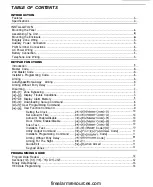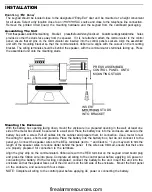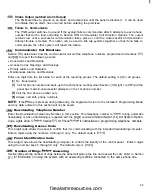
To display trouble conditions, enter
Trouble conditions are represented with the following lights:
Light
Zone 1
Zone 2
Zone 3
Zone 4
“Armed”
Low Battery.
lfthe batteryisdisconnected, itsvoltageis loworthe batteryfuseisopen,
will be displayed and can be reported.
AC Failure.
On loss of AC power, the “System” light will come ON but the keypad buzzer will
not sound. The keypad buzzer will sound if AC power remains off and the battery reaches a low
voltage. The delay before transmitting an AC Failure can be programmed from 1 to 99 minutes;
see Programming Section
Fuse Failure Siren or AUX Output.
A trouble is displayed if the siren fuse is open. If the AUX
output fuse fails, it will not be displayed but will be reported if programmed to do so.
Unsuccessful Communication Attempt.
If the digital communicator is cannot communicate
with the monitoring station after 8 attempts at each phone number, a trouble is generated. See
Section
Communication Variables. If a later attempt at communication is successful, the
trouble is cleared. The trouble can also be cleared by pressing the
Key to return to “ready”
from the Display Trouble Conditions mode.
Loss of Time on System Clock.
When the PC1 150 is powered up or reset, its internal clock will
need to be reset to the correct time. This trouble is cleared after exiting the Display Trouble
Conditions mode or when the time is reset; refer to
User Function Commands for
instructions for setting the time.
NOTE:
A loss-of-time trouble will
generated if the Test
Transmission and Auto-Arm times are not programmed.
NOTE:
If is pressed while in the Display Trouble Conditions mode, the last set of trouble
conditions will be displayed on the zone lights. This “trouble memory” is useful as a diagnostic tool
when installing and servicing the PC1 150.
Display Alarm Memory
Alarms caused during the previous armed period are stored in memory. To display the zones that went into
alarm, enter
The “System” light will FLASH and the alarms will be displayed on the flashing zone lights.
In addition to the last alarm memory, there are two history levels. After entering the memory mode, pressing any
key from [0] to will display two levels of alarm history. Each time a key is pressed, the keypad will beep 2 or
3 times to indicate which level of history is being viewed.
When the panel is armed and there are alarms in the first history level, the first level will be cleared and its alarms
moved to the second level. The second level events will be moved to the third level, and the existing third level
events will be deleted.
Downloading Call-up
Command
The
command is used to initiate a call to the downloading computer so that the panel can be accessed by
the computer. To be operational, this command must be enabled in the Section
Light 2. Sections
and
must be programmed with the downloading computer’s telephone number, the downloading access code
and the panel identification code. The
command can be programmed to require that an Access Code be
entered in order for the downloading call-up command to function: refer to Section
Light 4.
firealarmresources.com
Summary of Contents for PC1150
Page 36: ...firealarmresources com ...











































